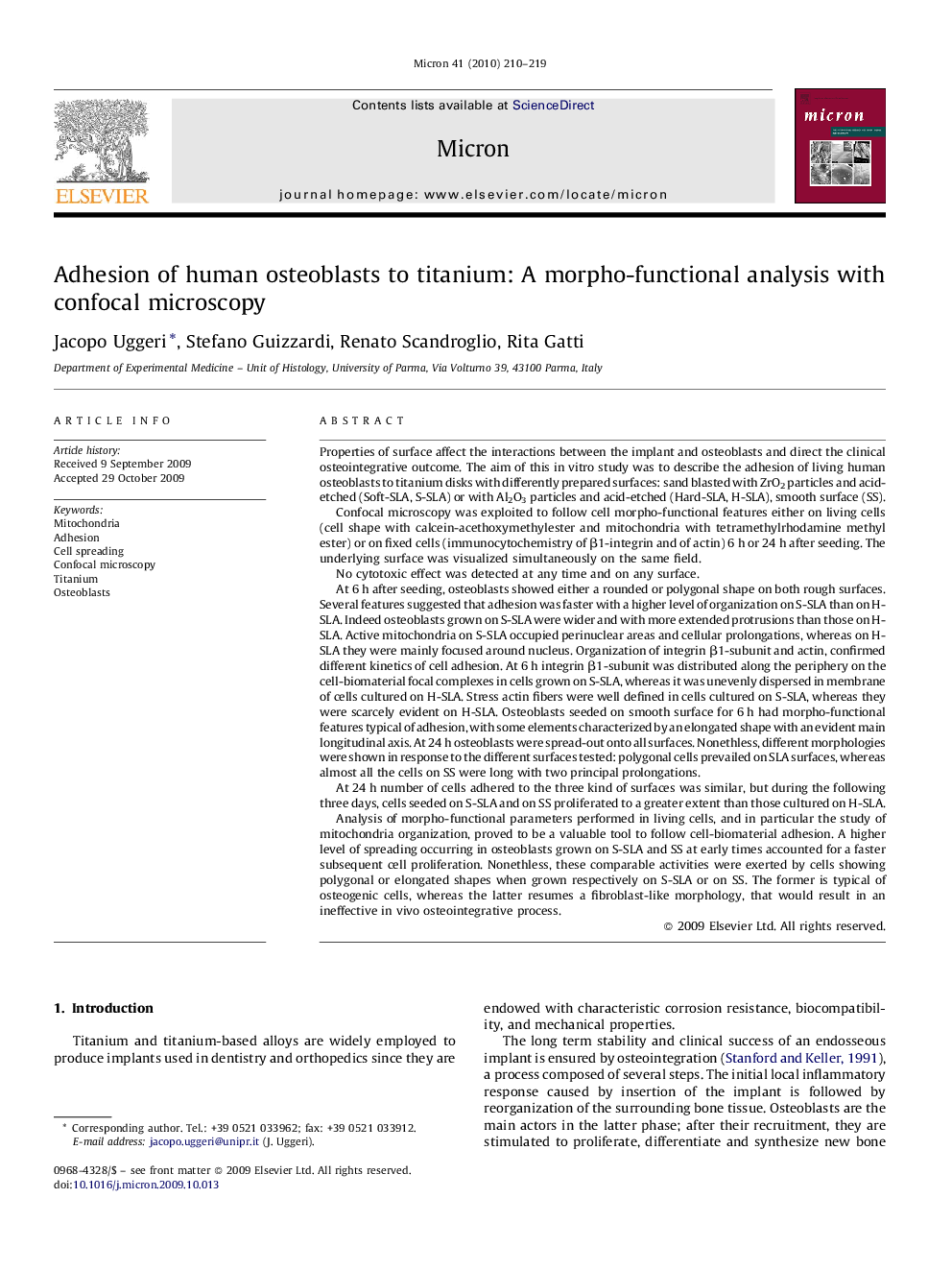| کد مقاله | کد نشریه | سال انتشار | مقاله انگلیسی | نسخه تمام متن |
|---|---|---|---|---|
| 1589279 | 1001984 | 2010 | 10 صفحه PDF | دانلود رایگان |

Properties of surface affect the interactions between the implant and osteoblasts and direct the clinical osteointegrative outcome. The aim of this in vitro study was to describe the adhesion of living human osteoblasts to titanium disks with differently prepared surfaces: sand blasted with ZrO2 particles and acid-etched (Soft-SLA, S-SLA) or with Al2O3 particles and acid-etched (Hard-SLA, H-SLA), smooth surface (SS).Confocal microscopy was exploited to follow cell morpho-functional features either on living cells (cell shape with calcein-acethoxymethylester and mitochondria with tetramethylrhodamine methyl ester) or on fixed cells (immunocytochemistry of β1-integrin and of actin) 6 h or 24 h after seeding. The underlying surface was visualized simultaneously on the same field.No cytotoxic effect was detected at any time and on any surface.At 6 h after seeding, osteoblasts showed either a rounded or polygonal shape on both rough surfaces. Several features suggested that adhesion was faster with a higher level of organization on S-SLA than on H-SLA. Indeed osteoblasts grown on S-SLA were wider and with more extended protrusions than those on H-SLA. Active mitochondria on S-SLA occupied perinuclear areas and cellular prolongations, whereas on H-SLA they were mainly focused around nucleus. Organization of integrin β1-subunit and actin, confirmed different kinetics of cell adhesion. At 6 h integrin β1-subunit was distributed along the periphery on the cell-biomaterial focal complexes in cells grown on S-SLA, whereas it was unevenly dispersed in membrane of cells cultured on H-SLA. Stress actin fibers were well defined in cells cultured on S-SLA, whereas they were scarcely evident on H-SLA. Osteoblasts seeded on smooth surface for 6 h had morpho-functional features typical of adhesion, with some elements characterized by an elongated shape with an evident main longitudinal axis. At 24 h osteoblasts were spread-out onto all surfaces. Nonethless, different morphologies were shown in response to the different surfaces tested: polygonal cells prevailed on SLA surfaces, whereas almost all the cells on SS were long with two principal prolongations.At 24 h number of cells adhered to the three kind of surfaces was similar, but during the following three days, cells seeded on S-SLA and on SS proliferated to a greater extent than those cultured on H-SLA.Analysis of morpho-functional parameters performed in living cells, and in particular the study of mitochondria organization, proved to be a valuable tool to follow cell-biomaterial adhesion. A higher level of spreading occurring in osteoblasts grown on S-SLA and SS at early times accounted for a faster subsequent cell proliferation. Nonethless, these comparable activities were exerted by cells showing polygonal or elongated shapes when grown respectively on S-SLA or on SS. The former is typical of osteogenic cells, whereas the latter resumes a fibroblast-like morphology, that would result in an ineffective in vivo osteointegrative process.
Journal: Micron - Volume 41, Issue 3, April 2010, Pages 210–219